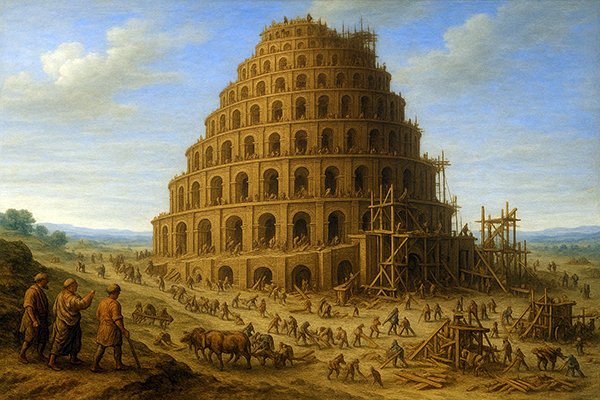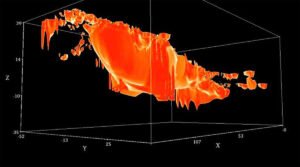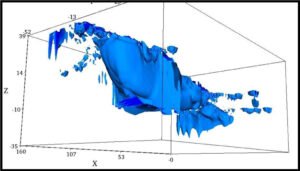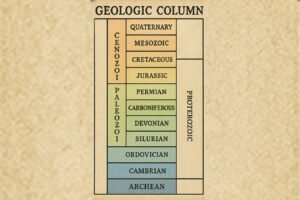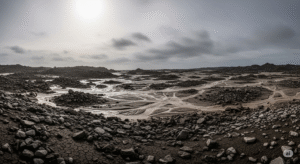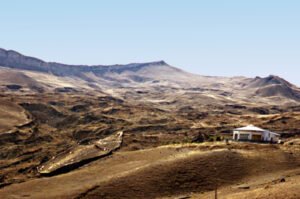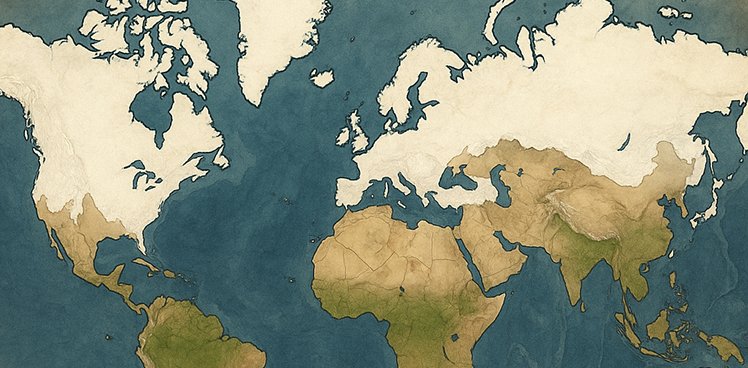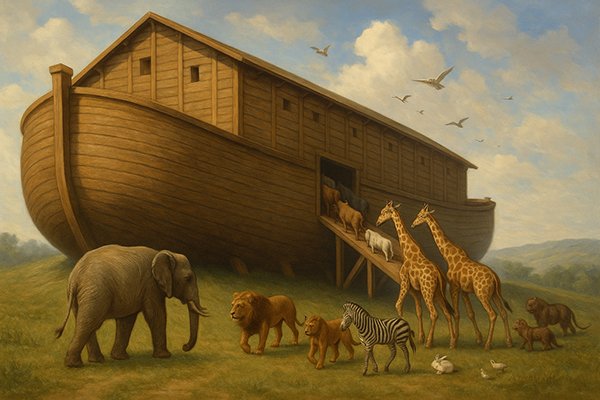The Tower of Babel
Babel- Where Was It?
The “tower of Babel” is a very important subject even though the account given in the Bible consists of just a very few verses. The discoveries of the last 150 years have shed tremendous light on the Biblical account and shown how completely accurate it is, but the one thing that can “pull it all together”, so to speak, is the subject we will now discuss.
Almost every civilization on earth has had its version of the flood story, but what evidence is there of the great dispersion of Noah’s family across the face of the earth? What evidence is there that the great division of languages- their “birth”, so to speak”- occurred at Babel?
For a long time, Ron has been interested in searching for the location of Babel, but the other projects dominated his time so completely that he never had the opportunity to follow up on it. But recently, he has begun field work, searching for the remains of the infamous tower.
In Oct. of 1990, Ron and Richard Rives first visited the region of southern Turkey above the Syrian border where the Euphrates River exits the Taurus mountains. Richard wanted to visit Nemrut Dağ (“dağ” means “mountain”), the burial site of the Seleucid king, Antiochus Epiphanes (62-32 BC) in order to examine the vast array of pagan statues there. Nemrut Dağ is located at the edge of the Taurus Mountains in the region Ron wanted to search for Babel, so off they went.
After examining Nemrut Dağ, the two made note of a large “hill” which looked like a “tell” (remains of an ancient city or village covered in soil) off in the distance that they felt should be explored. But pressed for time, they left for Israel. They decided that they would return as soon as possible to explore more.
His Search is Interrupted When He and His Group and Kidnapped
In August of 1991, they returned to Turkey, accompanied by Dr. Allen Roberts and Marv Wilson, to make an application to excavate Noah’s Ark. After meeting with officials and receiving a verbal approval, they were told that the written permit would be issued the next “working day”, which would be 4 days later due to a Turkish holiday. At that time, they all decided to go look for the tower of Babel while they waited. Unfortunately, they were taken hostage by terrorists on their way to the region and held for 21 days. After this ordeal, the search for Babel was put “on hold”.
It was 4 years later before Ron would consider returning to this still dangerous region. On Nov 30, 1995 he returned. We will present the results of that very exciting 1st investigation. But because of the nature of the subject of Babel, we must study it in light of all of the evidence available, beginning with the Biblical account. Then, we must gather all the evidences and view them in their proper context.
The Biblical Account of Babel
The account of the building of Babel and its tower is told in Genesis 11. It begins with the statement that all the people spoke the same language. Next, we are told of the “exodus” of a group of people from the area first settled by Noah and his descendants after the flood:
GEN 11:1 And the whole earth was of one language, and of one speech. 2 And it came to pass, as they journeyed from the east, that they found a plain in the land of Shinar; and they dwelt there.
They Traveled Along a River
Ron accepted the Biblical narrative as the final authority, and what this passage told him was that the people who left the area of the ark traveled to the west. Common sense adds the additional information that they traveled along a river- a water supply for the people as well as their flocks and herds would have been an absolute necessity. Therefore, Ron concluded that they began their journey at the beginning of one of the mountain streams that was a tributary of the Euphrates River near the area of the ark and followed it to the west until they came to a plain.
Studying topographical and flight maps of the region, he saw where the Euphrates River exited the mountainous region, roughly a 250 mile journey from the region of the ark. And there, where the mountains ended, was a tremendous plain.
Two Different Routes Possible
After more study, he found another route he believed they also could have taken which would have brought them to the same plain but by an easier and more direct path. This second route would have taken them in a southwest direction for about 140 miles until they reached the west side of Lake Van. From there, they would have traveled along a river about 50 miles through a mountain pass then exiting onto the vast plain where they would travel west until they reached the Euphrates. These are the only 2 natural east-west routes across Anatolia (People of the Hills, p. 7). Which route they took, we may never know. However, both would have brought the group to the same general area.
Putting himself in their place, Ron reasoned that once they found this massive plain, they would have traveled no further, provided the region contained all the natural resources that they would have needed, which it did. (We will discuss these later).
Here was what he believed was the “plain in the land of Shinar” where they “dwelt”. On the map, you can see the location of Mt. Ararat (the region of the ark) and in the top center is a black dot- this marks the spot where the mountains end and the plain begins, where Ron believes Babel was located.
“A Plain in the Land of Shinar”
The term “land of Shinar” has been interpreted to mean only the area far south of Ron’s site, the area of Babylon. But in fact, we have no firm evidence of the boundaries of this “land of Shinar”. Akkadian cuneiform texts mention “Shanhara” as being in northern Mesopotamia, west of Ninevah, the same mountainous region that is today called “Singar”.
The Amarna Letters (Egyptian) also mention a land called “Shanhar” which is also in northern Syria. These examples are in the same general region as Ron’s site. In fact, the name may even today still be reflected in a road sign of a town very near the site Ron examined- see photo. (In Turkish, “Ç” is pronounced “Ch”).
The next Biblical mention of Shinar occurs at a much later date:
DAN 1:2 And the Lord gave Jehoiakim king of Judah into his hand, with part of the vessels of the house of God: which he carried into the land of Shinar to the house of his god;...
Since this above verse refers to the Babylon of Nebuchadnezzar’s time, we know where it is located, which is far south of this region. Therefore, there are several possibilities to consider. Perhaps “Shinar”, like “Mesopotamia”, referred to the land between the Tigris and the Euphrates. Since the Tigris begins east of Ron’s site it would therefore be included in it; or perhaps in Daniel 1:2 it refers to the region (Babylonia) that during his time was dominated by the people (Chaldeans) who came from the more northerly region. Another Scripture adds additional information which we will discuss later when we study the cities of Asshur.
Baked Bricks and “Slime”
GEN 11:3 And they said one to another, Go to, let us make brick, and burn them thoroughly. And they had brick for stone, and slime had they for morter.
They built the city and tower of Babel with baked brick and used “slime” for mortar. Several weeks ago, when Ron again visited the region and examined a very large tell, he took samples of the baked brick and the mortar. The very black mortar consisted of a mixture of sand and tar (bitumen/asphalt) which hardens when dried. Since this is a petroleum product, we must inquire: did the area Ron had selected have a supply?
Petroleum Deposits Found in this Region
The 1985 Encyclopaedia Britannica states that the only oil fields in Turkey are in Ramana (west of this site) and Gaziantep (east of this site) both less than 100 miles away. The latest revision of the flight map shows oil wells in the immediate area and the pipeline between Gaziantep and Ramana follows directly under the region.
When Ron and Richard visited the area in 1990, they saw working oil derricks in the immediate vicinity. The presence of oil here, about 4,000 years after the time of Babel, indicates that an ample supply of bitumen most likely could have been obtained by the builders of this infamous city and tower. In fact, it may have been a major reason for selecting the area as this would have been a very necessary commodity.
“Let’s Build Us a City and Make Us a Name!”
GEN 11:4 And they said, Go to, let us build us a city and a tower, whose top may reach unto heaven; and let us make us a name, lest we be scattered abroad upon the face of the whole earth.
The command had been given to Noah’s family:
GEN 9:1 Be fruitful, and multiply, and replenish the earth.
How Quickly the People Rejected the God of Noah
Yet, in the passage about Babel we learn that when the time came that the mass of people set out from the Ararat region, they all congregated together to build ONE city in order to AVOID being scattered “upon the face of the whole earth”. They also wanted to “make US a name”. Evidences of ancient history all point to the fact that these earliest of people had, for the most part, rejected the true God, the Creator.
By the time of Abraham, just a little over 400 years after the flood, we learn that even Abraham’s family wasn’t completely faithful to God and combined their worship of Him with that of idols:
JOS 24:2 And Joshua said unto all the people, Thus saith the LORD God of Israel, Your fathers dwelt on the other side of the flood [Euphrates River] in old time, even Terah, the father of Abraham, and the father of Nachor: and they served other gods.
Yes, the people wanted their OWN name, and they received it as we will soon see. But I dare say it wasn’t what they had in mind.
God Intervenes
Gen 11:5 And the LORD came down to see the city and the tower, which the children of men builded. 6 And the LORD said, Behold, the people is one, and they have all one language; and this they begin to do: and now nothing will be restrained from them, which they have imagined to do.
This is a very thought-provoking passage that we need to think about. It plainly speaks of the fact that God said “nothing will be restrained from them, which they have imagined to do”. Noah and his sons were from the pre-flood world, a world whose people most certainly possessed knowledge and technology at the LEAST equal to that of today. This knowledge, at least some of it, was most certainly passed on to their immediate descendants.
The only thing that prevented a very advanced civilization from soon erupting was, in my opinion, the lack of personnel and the fact that for many, many years after the flood, they had to concentrate on breeding the animals and cultivating crops to sustain their lives.
When the time came that these things were established, the people could concentrate on other things. And with every great mind on earth together in accord and of one language, we cannot imagine what they could have done. We have been “brainwashed” with the idea of early man being primitive and animal-like, but the evidence does NOT show this to be the case.
After the Flood Man was not Primitive
When we study the archaeological journals and reports, we must be careful to separate the physical evidence from the opinions of the excavators or those writing the reports. They all assume that first came the cave-man, then fire, etc. And they assign dates to archaeological sites based on these assumptions.
But, if a “rocket scientist” suddenly found himself in a world of nothing but a barren planet of renewing plant and animal life, would we expect to find or build launch-pads? If the US were covered in dirt and archaeologists one day dug it up, would they date the fancy, modern homes of today as from the same time period as those in Appalachia that have no plumbing or electricity? I suspect they would place hundreds of years between them- maybe even thousands.
The point is that when mankind left their first home near Noah and the ark, they had knowledge. What they DIDN’T have were the resources. Later, we will discuss the documented evidences of advanced knowledge in this region that the scholars and historians admit they are at a loss to explain!
So, once again, God intervened. He has a timetable for world events which He controls. When mankind had reached the point of almost complete apostasy, He sent the flood. When mankind again embarked upon a path that was contrary to His plan, He intervened in a manner that caused them to comply with His command to “replenish the earth”.
The Confounding of the Language
GEN 11:7 Go to, let us go down, and there confound their language, that they may not understand one another's speech. 8 So the LORD scattered them abroad from thence upon the face of all the earth: and they left off to build the city.... 9 Therefore is the name of it called Babel; because the LORD did there confound the language of all the earth: and from thence did the LORD scatter them abroad upon the face of all the earth.
The name of the first city that they built was called “Babel”, which means simply “confusion” or “mingled” (“babel” is translated to read “mingled” 37 times in the Bible). The people wanted to “make US a name”, and they did.
Imagine the scene- this city of certainly thousands of people working side by side, building not only their city, but this massive tower, the first ever built after the flood, whose design was to extend up into the very clouds of “heaven”. (The fact that they chose this design may imply that they knew about similar pre-flood structures.)
Workmen at the top called for materials to those down below, who called to those below them, etc., etc., until the request reached the bottom. Then, the materials were passed up until they reached the workmen at the top. But then, something occurred that no one expected- they no longer could understand each other. Maybe the ones next to each other could understand one another, but those below them only heard gibberish when the next call came for materials. The scene must have been one of chaos. It’s impossible to imagine what it must have been like.
All we are told is that at some point after this “confusion” of languages, they ceased work on the city and were scattered “abroad upon the face of all the earth”. Later, we will study the completely compelling evidence which shows that it was indeed this very area that the different languages originated.
Nimrod, the Mighty Hunter
Genesis chapter 10 presents the “table of nations” which tells of all the descendants of Noah’s sons and how they were dispersed upon the face of the earth. In this chapter, we are told about one of Ham’s grandsons- Nimrod, son of Cush:
GEN 10:8 And Cush begat Nimrod: he began to be a mighty one in the earth. 9 He was a mighty hunter before the LORD: wherefore it is said, Even as Nimrod the mighty hunter before the LORD.
There are many traditions about Nimrod and our only confirmed knowledge of him is what we have read above and what is gleaned from the earliest tales and traditions. Until they built Babel, the people had been living in the same region as Noah, who would have certainly been the central authority figure (they were under the patriarchal system). Nimrod is the first person who is singled out in the Biblical account after the story of the flood, and we need to examine who he was.
He was “a mighty one in the earth” which indicates that he was a man of influence and power. We next learn that Nimrod was a “mighty hunter”, which many assume means that he was a conqueror. But let’s think just a minute. Noah’s family had left the area of the ark and set about to make ONE city so that they would NOT be scattered. This indicates to me that they were all in accord with each other. There would be no one to conquer.
The Bible says Nimrod was a HUNTER, not a conqueror. Why a hunter? After the flood, the entire animal kingdom had to be reestablished. In time, they reached sufficient numbers that they could be allowed to go free and spread over the face of the earth.
Predatory Animals After the Flood
Predatory animals, such as lions and tigers, reproduce (in litters) at a faster rate than humans or domesticated animals such as cattle, sheep and goats who usually give birth to only one or two (at the most) at a time. Think of these fierce animals, growing rapidly in numbers, roaming freely. It seems logical that this would have been the people’s greatest fear. It reminds me of the old movies set in the African jungles where wild animals attack and kill people in their tents and as they travel through the dense vegetation.
I believe Nimrod established himself as the great “protector” of the people as he hunted down and killed these fierce animals. And this would have given him great influence and power among the people.
Whether Nimrod acquired this reputation as a great hunter while still in the region of Noah or not, we don’t know. But if he did, it makes sense that the large group of people would feel more comfortable about venturing out into the unknown world with someone like Nimrod to protect them and this would place him in a position of great authority.
Further evidence of his great reputation is that the prevailing theme in the monuments and inscriptions of the kings and rulers of later civilizations was that of the king as a “mighty hunter”, which seems to have begun with Nimrod. And as such a great hunter and protector, he was a leader, ultimately having a profound effect upon the lives of billions of people throughout the following generations who followed the pagan religions which all seemed to have begun with Nimrod.
In fact, some of the very concepts that originated with him have remained through the ages and their influence can be found in almost every religion of today.
Paganism is Born
The evidences of archaeology in the entire region of the Middle East shows that from the earliest stages, even before writing had been developed, the people had idols. And these idols were indicative of several types of “gods” which soon were consolidated into “pantheons” of gods within each of the pagan religions.
The thing that we must never forget is that Satan has ever been busy trying to divert God’s people from the truth. And once they were separated from Noah, it appears that they were an easy target. As Ron constantly tries to remind people, Satan was cunning enough to “snooker” 1/3 of the angels of heaven as well as Adam and Eve, the most perfect humans ever created. So the rest of us don’t stand a chance against his wiles if we do not maintain a close relationship with the True God. And as we are told:
ECC 1:9... there is no new thing under the sun. 10 Is there anything whereof it may be said, See, this is new? it hath been already of old time, which was before us.
Satan- Behind Paganism
Satan, in “creating” his “new” religion, could only corrupt that which was true religion. As a former occupant of heaven, he knew the plan of salvation; he knew about the sacrificial system and what it represented; he knew about the Son of God Who would one day come to earth in the form of humanity; he knew about God’s messengers (ministering spirits), the angels and their work.
He also knew how his evil legions of fallen angels worked and he used this knowledge to corrupt the true religion into pagan religion. And he knew how to use men and their selfish motivations to accomplish his evil designs.
Early Pagan Gods and Goddesses
One early type of idol found all through the area is the “mother goddess of fertility”. After the flood, first and foremost in importance among the people would have been procreation- having children, as well as the rapid reproduction among the animals and the crops.
Also, there is early evidence of nature worship, such as the sun and the moon. Everything was dependent upon the sun for life. The moon was perhaps looked upon as something pertaining to the seasons for planting, etc. We don’t fully understand.
Also, the early pantheons of “gods” consisted of eight- the same number of people who came through the flood in the ark. To these eight “gods” were assigned separate attributes of the true God and things expanded from there. Thus was the concept of ancestor worship incorporated into the pagan system.
It’s an extremely complicated subject, but ONE thing is certain- by the time man began to spread across the face of the earth, fully developed “sun worship” went with him. This indicates that this concept in religion- “nature” worship manifested also as “ancestor” worship- was developed BEFORE the confusion of the languages.
How Could the People Turn from the True God so Quickly?
The evidence available on this subject indicates to us that Nimrod was the person who developed the concept of the sun god and in fact, claimed to be the god, himself.
How could this happen? For a moment, let’s reflect back to their situation. Mankind was “beginning again”, so to speak. When the people remained around Noah, they were exposed to the knowledge of the True God. But life was hard. When mankind was first put upon the earth, it was perfect. Now, after the cataclysm of the flood, the entire face of the earth was harsh and rugged. Plants had to be cultivated, animals had to be bred and cared for. Everything had to be reestablished under the harshest of conditions.
Hearing the story of the flood and the wickedness of mankind which brought about the flood, it appears that in time, the majority of the people wanted to get away from Noah and his God and “make US a name”. They also, it appears, wanted a “new god” or religion, or at least accepted it quite readily. Noah’s God couldn’t be seen but Satan’s substitutes were visible, even if only in a stone statue or seen in the physical presence of the sun, etc. (To a great extent the same is true today.)
The Pagan Belief in Immortality
The nature of their “new” religion, from the archaeological evidences, show that it was also based on the acceptance of the first lie that Satan told Eve when he persuaded her to eat of the fruit of the tree of the knowledge of good and evil:
GEN 3:4 And the serpent said unto the woman, Ye shall not surely die: 5 For God doth know that in the day ye eat thereof, then your eyes shall be opened, and ye shall be as gods, knowing good and evil.
The first lie was that man doesn’t die- that he is immortal-, a lie that has lived on in the still popular concept of “life after death” even though the Word of God plainly states that “the dead know not any thing,...”
(Ecc. 9:5) and “His breath goeth forth, he returneth to his earth; in that very day his thoughts perish”.
Man has Not Obtained Immortality Yet
(Psa 146:4).There is only one Who is immortal:... the blessed and only Potentate, the King of kings, and Lord of lords; 16 Who only hath immortality,.... (1TI 6:15).
The promise of eternal life to the righteous is a promise of FUTURE reward at the resurrection:
1CO 15:52 In a moment, in the twinkling of an eye, at the last trump: for the trumpet shall sound, and the dead shall be raised incorruptible, and we shall be changed. 53 For this corruptible must put on incorruption, and this mortal must put on immortality. 54 So when this corruptible shall have put on incorruption, and this mortal shall have put on immortality, then shall be brought to pass the saying that is written, Death is swallowed up in victory.
The ancient records reveal the incredible extent of the belief by the early peoples in an “after-life” that begins the instant of death and the necessity of appeasing the “gods” to insure good fortune both in this life AND in the future life.
The archaeological evidence seems to indicate that every group that left the immediate region of the ark had a belief in some type of idolatry as their burials contain “trinkets” for the person to have in their “next life”. The earliest idols seem to indicate that the people began worshiping a goddess typed “the mother goddess of fertility”.
Then there are idols of animals, especially bulls. After all, cattle were vital to early existence due to their milk production and as food.
Early Pagan Religions Share Many Similar Attributes
But then there appears in the major civilizations such as Egypt and the cities up and down the Tigris and Euphrates a series of gods and goddesses headed by a main god who was considered the creator and his favored son who was ultimately the “sun” god.
Incorporated into these fully formed “religions” were the early “mother goddesses” and “bull gods” among others. And the most important thing to recognize is that the kings and leaders of these early civilizations claimed that they were either the earthly representative of the sun god, OR, in some cases, they claimed to be the god reincarnated in human form.
For those who want to study this subject more in-depth, I suggest that you read “The Two Babylons” by Alexander Hislop. But in a nutshell, it can be summed up in a passage from Hislop’s above-mentioned book, whose purpose is to expose remnants of these pagan religions that are still manifested in all religions today, including (unfortunately) Christianity :
Paganism Designed to Control the Masses
“The object [of this pagan religion] was to bind all mankind in blind and absolute submission to a hierarchy entirely dependent upon the sovereigns of Babylon”.
Think about it for a moment- the powerful leaders, beginning with Nimrod, could get the people to do anything they wanted by convincing them that they (the leaders) were “god in the flesh” or at least the “god’s” chosen representative on earth, and that they MUST obey this “god” (or “god’s representative”) or they would suffer terrible tortures in the blackness of the netherworld after their “death”, tormented by monsters and horrible creatures.
They likewise convinced the people that the success of their harvests or flocks or having more children depended upon appeasing the “god”, who made known his wishes through his “earthly representative”.
The mediatorship of Christ, the Son of God, was here replaced by a human being- either the king or priest who “spoke infallibly” on behalf of the “god”, or the king who claimed to be the actual reincarnation of the “god”, ruling mankind from his throne as every word from his mouth was considered infallible. This concept has been preserved throughout the ages until even today when men worship the Lord in vain, “teaching for doctrines the commandments of men” (Mat. 15:19) and the “doctrines of devils”. (1Tim. 4:1)
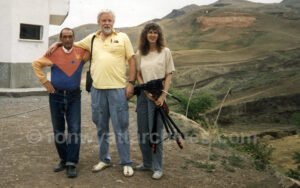
Welcome to the Ron Wyatt Archives. I'm Mary Nell (Ron's wife) and this site will attempt to fully document Ron Wyatt's work and discoveries. This website will be an ongoing project to document his work on all his various discoveries. Please check back often as new things will be added constantly.
| READ MORE |

